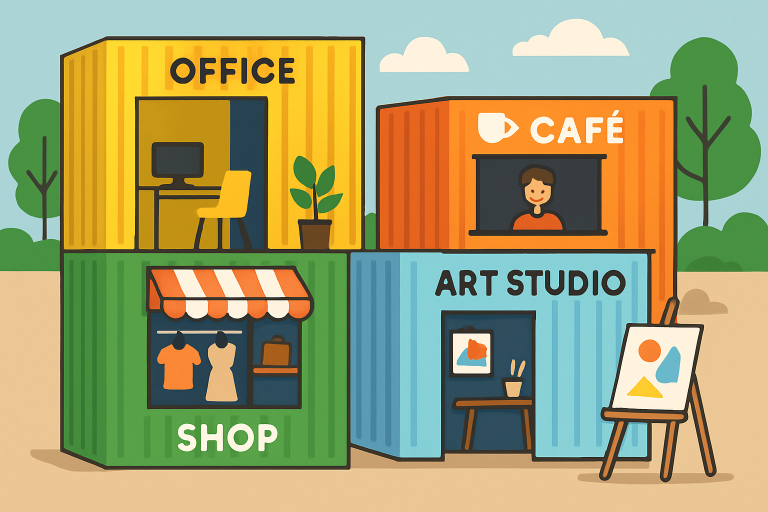Creative Uses for Portable Storage Containers

Table of Contents
Introduction
Innovative minds have found remarkable ways to repurpose portable storage containers into far more than just temporary storage. Their sturdy structure, customizable interiors, and adaptable nature make them a reliable choice for countless creative and functional applications. Whether aiming to expand business opportunities or solve community needs, portable conex containers have become the canvas for innovation, thanks to their durability and versatility.
From bustling urban centers to remote rural areas, these containers are repurposed for both personal and public benefit. Their inherent portability enables them to serve solutions where traditional construction may be impractical or prohibitively expensive. By utilizing containers as flexible building blocks, individuals and organizations are developing faster, more sustainable alternatives to conventional spaces.
As a result, portable storage containers are quickly redefining modern work, commerce, and community environments. Their eco-friendly aspect, promoted through upcycling and recycling, also appeals to those seeking greener options, making them a cornerstone in sustainable design.
Mobile Offices
One of the most prominent uses for storage containers is as mobile offices. Enterprises undertaking construction projects, outdoor events, or any venture requiring temporary workspace can find a practical solution in custom container offices. Outfitted with insulation, HVAC, windows, and modern office amenities, these units serve employees comfortably no matter where they’re deployed. Not only do they provide a secure and weather-resistant environment, but they can also be quickly relocated as project needs shift.
Pop-Up Retail Shops
The pop-up retail trend owes much of its flexibility to portable storage containers. Forward-thinking entrepreneurs are transforming these units into chic and effective pop-up shops, fully branded and equipped with modular shelving, display cases, and even digital signage. Because they are mobile, vendors can efficiently trial different neighborhoods or events, creating buzz and testing markets without committing to extensive leases.

Art Studios and Creative Spaces
Many artists and creative professionals crave solitude to fuel their imagination. Repurposed storage containers make ideal studios, offering a private and tailored sanctuary for painting, sculpting, or recording music. With adaptable interiors, it’s possible to ensure proper lighting and ventilation, while modifications such as skylights and acoustic insulation nurture productivity and creativity.
Using containers for creative expression has also inspired community art initiatives. Some cities encourage local artists to occupy container studios and collaborate in public spaces, breathing new life into underutilized urban areas.
Community Centers and Libraries
Communities with limited infrastructure are turning to storage containers as cost-efficient options for community centers and libraries. Outfitted with comfortable seating, bookshelves, computers, and Wi-Fi capability, these modular buildings serve as safe spaces for learning, socializing, and community workshops. Community-driven projects often find that container spaces provide a scalable starting point, with the ability to expand or relocate as the population’s needs evolve.
Mobile Cafés and Food Stands
Food entrepreneurs benefit from the agility of container-based cafés and food stands. Compact yet highly customizable, containers can be designed to house commercial kitchens, service counters, and al fresco dining spaces. This approach allows vendors to participate in festivals, farmers’ markets, or set up permanently in high-traffic areas, all without extensive construction costs. Their unmistakable design also attracts attention and can become a key part of a business’s brand identity.
Emergency Shelters
In crises or disaster zones where rapid shelter is essential, converted storage containers offer a critical lifeline. Their robust steel construction withstands harsh weather, providing secure temporary housing for displaced individuals. With proper planning, these units can include insulation, plumbing, and electricity, making them viable interim homes while permanent recovery gets underway. Innovative NGOs and relief organizations now deploy container shelters worldwide as part of their rapid response strategies.
Educational Facilities
Educational institutions, especially in areas with surging enrollments or constrained budgets, take advantage of storage containers to create quick, comfortable additional learning spaces. These mobile classrooms, labs, or workshops can be tailored to specific needs, equipped with desks, smart boards, and technology infrastructure, and positioned wherever additional capacity is needed most. This modular approach supports continuous access to education, even during school renovations or emergencies.
Recreational Spaces
Beyond utilitarian functions, storage containers provide an opportunity for recreation. They are commonly converted into gyms, yoga studios, gaming lounges, or meditation rooms, serving both personal wellness needs and community fitness initiatives. Light construction and relocation flexibility enable these recreational spaces to serve hard-to-reach communities or supplement existing facilities effectively.
Portable storage containers embody the intersection of innovation, affordability, and efficiency. By reimagining what these containers can become, modern users are not only saving resources but also expanding the possibilities for both individual and collective spaces. Their ongoing evolution stands as proof of human ingenuity and the drive for sustainable solutions in changing times.
Conclusion
Portable storage containers offer far more than just extra space—they can be transformed into versatile solutions that support creativity, organization, and efficiency. From mobile offices and pop-up shops to event booths and art studios, their flexibility allows individuals and businesses to adapt spaces to their unique needs. By thinking beyond traditional storage, users can unlock the full potential of these containers, turning simple structures into innovative assets that enhance productivity and inspire new possibilities.






